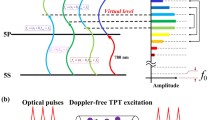Abstract
Time is one of the base SI unit and the most accurately measured physical quantity. Atomic optical frequency standards have been realized with 10−18 level of accuracy and stability (Ohmae et al., Advanced Quantum Technologies 4: 2100015, 2021), which are two orders of magnitude better compared to the present SI second, based on Cesium microwave standard. Such optical clocks are potential candidates for the re-definition of the SI second in the near future (https://www.bipm.org/en/publications/mises-en-pratique/standard-frequencies-second). However, smooth and effective transition of “Time” requires that more and more laboratories in various countries across the world are able to realize such optical clocks in their standards laboratory. Realization of such clocks requires an ultra-stable narrow linewidth laser, used as the oscillator for interrogating the clock transition in the atomic species. This necessity makes the development of a narrow linewidth ultra-stable laser oscillator, usually realized using a laser and a stable high-finesse cavity, an essential requirement. The present work describes various design requirements to realize such an oscillator that can be customized over a wide range of frequencies for interrogating different atomic species in optical domain. A practically realizable theoretical calculation has been presented, which should pave the way for in-house construction of the oscillator.






Similar content being viewed by others
References
https://www.bipm.org/en/publications/mises-en-pratique/standard-frequencies-second.
M. Takamoto, F.L. Hong, R. Higashi and H. Katori, An optical lattice clock. Nature, 435 (2005) 321–324.
J. C. Bergquist, U. Tanaka, R. E. Drullinger, W. M. Itano, D. J. Wineland, S. A. Diddams, L. W. Hollberg, E A. Curtis and C. W. Oates, A mercury-ion optical clock, Proc. 6th Symposium on frequency standards and metrology, St. Andrews, South Carolina, USA(2001) 100–105
F. Riehle, Frequency standards basics and applications, Wiley-VCH verlag GmbH Co. KgaA, (2004), pp 1, 4
J.D. Sterk, L. Luo, T.A. Manning, P. Maunz and C. Monroe, Photon collection from a trapped ion-cavity system. Phys. Rev. A, 85 (2012) 062308-1–062308-8.
N. Yu and L. Maleki, Lifetime measurements of the 4f14 5d metastable states in single ytterbium ions. Phys. Rev. A, 61 (2000) 022507.
K.C. Harvey and C.J. Myatt, External-cavity diode laser using a grazing-incidence diffraction grating. Opt. Lett., 16 (1991) 910–912.
H. Abitan and T. Skettrup, Laser resonators with several mirrors and lenses with the bow-tie laser resonator with compensation for astigmatism and thermal lens effects as an example. J. Opt. A Pure Appl. Opt., 7 (2005) 7–20.
M. Suter and P. Dietiker, Calculation of the finesse of an ideal Fabry-Perot resonator. Appl. Opt., 53 (2014) 7004–7010.
A. Yariv, Quantum electronics, 3rd edn. Wiley (1991), pp. 106–145.
T. Legero, T. Kessler and U. Sterr, Tuning the thermal expansion properties of optical reference cavities with fused silica mirrors. J. Opt. Soc. Am. B, 27 (2010) 914–919.
T. Kessler, C. Hagemann, C. Grebing, T. Legero, U. Sterr, F. Riehle, M.J. Martin, L. Chen and J. Ye, A sub-40-mHz-linewidth laser based on a silicon single-crystal optical cavity. Nature Photon., 6 (2012) 687–692.
D. Świerad, S. Häfner, S. Vogt, B. Venon, D. Holleville, S. Bize, A. Kulosa, S. Bode, Y. Singh, K. Bongs and E.M. Rasel, Ultra-stable clock laser system development towards space applications. Sci. Rep., 6 (2016) 33973.
R.W.P. Drever, J.L. Hall, F.V. Kowalski, J. Hough, G.M. Ford, A.J. Munley and H. Ward, Laser phase and frequency stabilization using an optical resonator. Appl. Phys. B, 31 (1983) 97–105.
A. O’Keefe and D.A.G. Deacon, Cavity ring-down spectrometer for absorption measurements using pulsed laser sources. Rev. Sci. Instrum., 59 (1988) 2544–2551.
W.M. Itano, J.C. Bergquist, J.J. Bollinger, J.M. Gilligan, D.J. Heinzen, F.L. Moore, M.G. Raizen and D.J. Wineland, Quantum projection noise: Population fluctuation in two-level systems. Phys. Rev. A, 47 (1993) 3554–3570.
N. Ohmae, M. Takamoto, Y. Takahashi, M. Kokubun, K. Araki, A. Hinton, I. Ushijima, T. Muramatsu, T. Furumiya, Y. Sakai, N. Moriya, N. Kamiya, K. Fujii, R. Muramatsu, T. Shiimado and H. Katori, Transportable strontium optical lattice clocks operated outside laboratory at the level of 10–18 uncertainty. Adv. Quantum Technol., 4 (2021) 2100015.
L.S. Ma, P. Jungner, J. Ye and J.L. Hall, Delivering the same optical frequency at two places: accurate cancellation of phase noise introduced by an optical fiber or other time-varying path. Opt. Lett., 19 (1994) 1777–1779.
S.M. Foreman, K.W. Holman, D.D. Hudson, D.J. Jones and J. Ye, Remote transfer of ultrastable frequency references via fiber networks. Rev. Sci. Instrum., 78 (2007) 021101.
N.R. Newbury, P.A. Williams and W.C. Swan, Coherent transfer of an optical carrier over 251 km. Opt. Lett., 32 (2007) 3056–3058.
S.T. Dawkins, J.J. McFerran and A.N. Luiten, Considerations on the measurement of the stability of oscillators with frequency counters. IEEE Trans. Ultrason. Ferroelectr. Frequency Control, 54 (2007) 918–925.
Acknowledgements
Sandip Kumar Ghosh is grateful to university grants commission (UGC) for providing fellowship for this research work. Manoj Das is grateful to CSIR-National Physical Laboratory for providing support for this work.
Author information
Authors and Affiliations
Corresponding author
Additional information
Publisher's Note
Springer Nature remains neutral with regard to jurisdictional claims in published maps and institutional affiliations.
Rights and permissions
Springer Nature or its licensor (e.g. a society or other partner) holds exclusive rights to this article under a publishing agreement with the author(s) or other rightsholder(s); author self-archiving of the accepted manuscript version of this article is solely governed by the terms of such publishing agreement and applicable law.
About this article
Cite this article
Ghosh, S.K., Panja, S. & Das, M. A Laser Based Universal Oscillator for Next Generation Optical Frequency Standards. MAPAN 38, 641–649 (2023). https://doi.org/10.1007/s12647-023-00651-z
Received:
Accepted:
Published:
Issue Date:
DOI: https://doi.org/10.1007/s12647-023-00651-z




